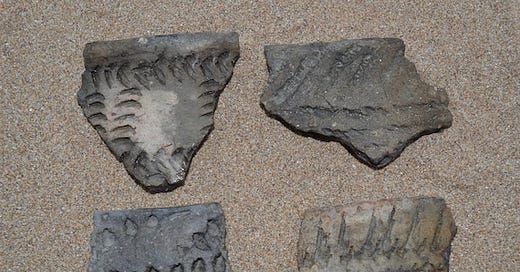Summer is here and there are a few writers, songs, places I like to revisit each yearto bring back that feeling of the dog days of summer. One of those writers is the American poet Gustaf Sobin who spent four decades in Provence France, to be close to his mentor, the lauded poet and World War II veteran, Rene Char, before passing away in 2005.
Sobin first came to my attention because he was the only American who attended the famous Le Thor lectures of Heidegger that were held on Char’s estate, “in the deep shade of [his] plane tree”, where, among other things, Heidegger would expand on a single line of Heraclitus for the afternoon in the midst of other French and German writers and philosophers in the dry air of Provence.
Fragments were a major influence on Sobin’s writing in both subject matter and style. Two of his three books of essays were reflections on the broken pottery and other artifacts found in his surrounding area of southern France, artifacts that date back to the Neolithic period.
In his book Luminous Debris he states, “[i]n every archaic culture, a grammar of images, of pictographs, precedes that of letters: the sign, or sema, is first of all pictorial.”1 Uncovering a hidden language from the ancient past through the remnants that still exist today carried over into his poetry as well, perhaps influenced by the reading of ancient Greek fragments under the plane trees with Char and Heidegger.
You can see this influence in his own poetry. The poem “Tracing A Thirst” from Breaths’ Burial begins like this:
called it: tracing a
thirst, the poem
as it
sluices a
passage; with each,
dry
utterance, edges
towards its
own
ob-
fuscated source.
His poems lack pronouns and capitalization making the words hang in the air. Something is missing and the lines seem to start in mid sentence. He also breaks up words, lines, and sentences so the words seem to slowly tumble down the page. I usually read only a couple of poems at one time, if I read too many it feels like walking through a museum without stopping to look at any exhibit in particular.
He is noted as saying that living in France for his whole adult life, speaking in French but writing in English, gave him a distance from his native tongue allowing English to become more fresh to his ear. “The words take on a kind of buoyancy… they’re free of so much exhausted usage [and] day-to-day attrition.”2 In reading his poems, everyday words can appear foreign again, like some archaic symbol.
The structure of his poems tend to be very vertical, like the one above, but he did have a series called “Transparent Itineraries” which would be a recurring theme throughout all his books of poetry beginning in 1979.
This series is more horizontal, less fractured, and the lines were the “leftovers” from the year that didn’t make it into one of his more structured poems. He states that each passage was a sign that linked with the next through some transparent meaning and continued throughout his later books.
In Breaths’ Burials, the same works as the poem above, the “Transparent Itineraries” from 1991 begins:
were no origins (so we were told), only ends.
nowhere, really, to reach except those occasional places in which, sometimes, we’d orchestrate those ends. set their emptiness - in measured bars, volutes, ellipses - to sound.
This archaeology of language leaves the reader with more questions than answers, wandering through words whose meanings are suspended, floating like clouds in the Provence sky.
…
Fragments have a tendency to reveal more by missing something. Interpretation requires filling in the gaps. If the fragment was wholly given, it would probably get less attention because of the assumption that it wholly presents itself and there is therefore nothing more to see. It is the absence that fragments preserve. Perhaps the recognition of this absence is what keeps the fragment alive today where they act as a passage through which to look for our own origins through these gifts of the past.
Gustaf Sobin, Luminous Debris, p. 45
Edward Foster, “An Inteveriew with Gustaf Sobin”, Talisman: A Journal of Contemporary Poetry and Poetics 10 (Spring 1993), p. 36.





I work with the very elderly, and sometimes their memory is in “fragments“. Perhaps it is mostly intact and just missing a fragment or two, but sometimes there are only scattered, but very intact, fragments. It can be difficult to piece them back together, but with some patience and perhaps a dash of intuition often you can see the wisdom and intent they are attempting to express.